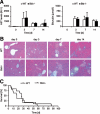The BH3-only protein bid does not mediate death-receptor-induced liver injury in obstructive cholestasis
- PMID: 19661444
- PMCID: PMC2731126
- DOI: 10.2353/ajpath.2009.090304
The BH3-only protein bid does not mediate death-receptor-induced liver injury in obstructive cholestasis
Abstract
The accumulation of bile acids during obstructive cholestasis causes liver injury and fibrosis, which is at least partly mediated by the death receptors Tumor necrosis factor-related apoptosis-inducing ligand, Tumor necrosis factor-alpha, and Fas. The BH3-interacting domain death agonist Bid is a critical mediator of death receptor-induced apoptosis in hepatocytes. Our aim for this study was, therefore, to elucidate whether Bid also mediates death receptor-induced liver injury in obstructive cholestasis. Overall, survival and various aspects of liver injury were analyzed in wild-type and Bid(-/-) mice after bile duct ligation (BDL), a commonly used model to study obstructive cholestasis in mice. Liver injury was examined at 3, 7, and 14 days after BDL. Loss of Bid did not affect the number of bile infarcts, serum aspartate aminotransferase values, or animal survival. Processing of procaspase-3 and procaspase-9, and caspase-3 enzyme activities, were not detectable in either group, and Bid(-/-) mice displayed the same pattern of terminal deoxynucleotidyl transferase-mediated dUTP nick-end labeling positive hepatocytes as wild-type controls following BDL. In contrast to Fas-receptor deficient lpr mice, hepatic fibrosis and the inflammatory response was not affected by loss of Bid. Together, these data suggest that Bid is not a downstream target of death receptors in obstructive cholestasis and does not significantly contribute to bile acid induced liver injury and fibrosis.
Figures






Similar articles
-
Cholestasis increases tumor necrosis factor-related apoptotis-inducing ligand (TRAIL)-R2/DR5 expression and sensitizes the liver to TRAIL-mediated cytotoxicity.J Pharmacol Exp Ther. 2002 Nov;303(2):461-7. doi: 10.1124/jpet.102.040030. J Pharmacol Exp Ther. 2002. PMID: 12388624
-
Hepatocyte apoptosis after bile duct ligation in the mouse involves Fas.Gastroenterology. 1999 Sep;117(3):669-77. doi: 10.1016/s0016-5085(99)70461-0. Gastroenterology. 1999. PMID: 10464144
-
The strength of the Fas ligand signal determines whether hepatocytes act as type 1 or type 2 cells in murine livers.Hepatology. 2009 Nov;50(5):1558-66. doi: 10.1002/hep.23176. Hepatology. 2009. PMID: 19711425 Free PMC article.
-
Mitochondrial dysfunction in cholestatic liver diseases.Front Biosci (Elite Ed). 2012 Jan 1;4(6):2233-52. doi: 10.2741/539. Front Biosci (Elite Ed). 2012. PMID: 22202034 Review.
-
Pathophysiology of sepsis-induced cholestasis: A review.JGH Open. 2022 May 25;6(6):378-387. doi: 10.1002/jgh3.12771. eCollection 2022 Jun. JGH Open. 2022. PMID: 35774351 Free PMC article. Review.
Cited by
-
Osteopontin is an initial mediator of inflammation and liver injury during obstructive cholestasis after bile duct ligation in mice.Toxicol Lett. 2014 Jan 13;224(2):186-95. doi: 10.1016/j.toxlet.2013.10.030. Epub 2013 Nov 2. Toxicol Lett. 2014. PMID: 24188933 Free PMC article.
-
Plasma biomarkers of liver injury and inflammation demonstrate a lack of apoptosis during obstructive cholestasis in mice.Toxicol Appl Pharmacol. 2013 Dec 15;273(3):524-31. doi: 10.1016/j.taap.2013.09.023. Epub 2013 Oct 3. Toxicol Appl Pharmacol. 2013. PMID: 24096036 Free PMC article.
-
Bile acid-induced necrosis in primary human hepatocytes and in patients with obstructive cholestasis.Toxicol Appl Pharmacol. 2015 Mar 15;283(3):168-77. doi: 10.1016/j.taap.2015.01.015. Epub 2015 Jan 28. Toxicol Appl Pharmacol. 2015. PMID: 25636263 Free PMC article.
-
cAMP-guanine exchange factor protection from bile acid-induced hepatocyte apoptosis involves glycogen synthase kinase regulation of c-Jun NH2-terminal kinase.Am J Physiol Gastrointest Liver Physiol. 2011 Aug;301(2):G385-400. doi: 10.1152/ajpgi.00430.2010. Epub 2011 May 5. Am J Physiol Gastrointest Liver Physiol. 2011. PMID: 21546580 Free PMC article.
-
Inflammation and Cell Death During Cholestasis: The Evolving Role of Bile Acids.Gene Expr. 2019 Nov 4;19(3):215-228. doi: 10.3727/105221619X15614873062730. Epub 2019 Jun 28. Gene Expr. 2019. PMID: 31253204 Free PMC article. Review.
References
-
- Higuchi H, Miyoshi H, Bronk SF, Zhang H, Dean N, Gores GJ. Bid antisense attenuates bile acid-induced apoptosis and cholestatic liver injury. J Pharmacol Exp Ther. 2001;299:866–873. - PubMed
-
- Takikawa Y, Miyoshi H, Rust C, Roberts P, Siegel R, Mandal PK, Millikan RE, Gores GJ. The bile acid-activated phosphatidylinositol 3-kinase pathway inhibits Fas apoptosis upstream of bid in rodent hepatocytes. Gastroenterology. 2001;120:1810–1817. - PubMed
-
- Yerushalmi B, Dahl R, Devereaux MW, Gumpricht E, Sokol RJ. Bile acid-induced rat hepatocyte apoptosis is inhibited by antioxidants and blockers of the mitochondrial permeability transition. Hepatology. 2001;33:616–626. - PubMed
-
- Reinehr R, Graf D, Haussinger D. Bile salt-induced hepatocyte apoptosis involves epidermal growth factor receptor-dependent CD95 tyrosine phosphorylation. Gastroenterology. 2003;125:839–853. - PubMed
-
- Lo Ten, Foe JR, Kwee ML, Rooimans MA, Oostra AB, Veerman AJ, van Weel M, Pauli RM, Shahidi NT, Dokal I, Roberts I, Altay C, Gluckman E, Gibson RA, Mathew CG, Arwert F, Joenje H. Somatic mosaicism in Fanconi anemia: molecular basis and clinical significance. Eur J Hum Genet. 1997;5:137–148. - PubMed
Publication types
MeSH terms
Substances
Grants and funding
LinkOut - more resources
Full Text Sources
Molecular Biology Databases
Research Materials
Miscellaneous

